| View of Florence from San Miniato | |
|---|---|
 | |
| Artist | Thomas Cole |
| Year | 1837 |
| Medium | Oil on canvas |
| Location | Cleveland Museum of Art, Cleveland |
View of Florence from San Miniato is an oil on canvas painting by American artist Thomas Cole.
| View of Florence from San Miniato | |
|---|---|
 | |
| Artist | Thomas Cole |
| Year | 1837 |
| Medium | Oil on canvas |
| Location | Cleveland Museum of Art, Cleveland |
View of Florence from San Miniato is an oil on canvas painting by American artist Thomas Cole.
It was completed in 1837 and is currently housed at Cleveland Museum of Art. [1] [2]
The painting is a panorama of Florence, showing a Romantic response to the Italian landscape. [3]
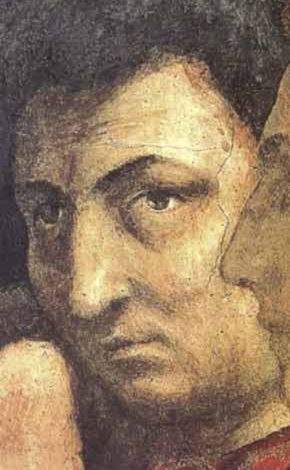
Masaccio, born Tommaso di Ser Giovanni di Simone, was a Florentine artist who is regarded as the first great Italian painter of the Quattrocento period of the Italian Renaissance. According to Vasari, Masaccio was the best painter of his generation because of his skill at imitating nature, recreating lifelike figures and movements as well as a convincing sense of three-dimensionality. He employed nudes and foreshortenings in his figures. This had seldom been done before him.

Visual art of the United States or American art is visual art made in the United States or by U.S. artists. Before colonization, there were many flourishing traditions of Native American art, and where the Spanish colonized Spanish Colonial architecture and the accompanying styles in other media were quickly in place. Early colonial art on the East Coast initially relied on artists from Europe, with John White the earliest example. In the late 18th and early 19th centuries, artists primarily painted portraits, and some landscapes in a style based mainly on English painting. Furniture-makers imitating English styles and similar craftsmen were also established in the major cities, but in the English colonies, locally made pottery remained resolutely utilitarian until the 19th century, with fancy products imported.

Frederic Edwin Church was an American landscape painter born in Hartford, Connecticut. He was a central figure in the Hudson River School of American landscape painters, best known for painting large landscapes, often depicting mountains, waterfalls, and sunsets. Church's paintings put an emphasis on realistic detail, dramatic light, and panoramic views. He debuted some of his major works in single-painting exhibitions to a paying and often enthralled audience in New York City. In his prime, he was one of the most famous painters in the United States.

American Impressionism was a style of painting related to European Impressionism and practiced by American artists in the United States from the mid-nineteenth century through the beginning of the twentieth. The style is characterized by loose brushwork and vivid colors with a wide array of subject matters but focusing on landscapes and upper-class domestic life.

The Hudson River School was a mid-19th-century American art movement embodied by a group of landscape painters whose aesthetic vision was influenced by Romanticism. Early on, the paintings typically depicted the Hudson River Valley and the surrounding area, including the Catskill, Adirondack, and White Mountains.

Thomas Cole was an English-born American artist and the founder of the Hudson River School art movement. Cole is widely regarded as the first significant American landscape painter. He was known for his romantic landscape and history paintings. Influenced by European painters, but with a strong American sensibility, he was prolific throughout his career and worked primarily with oil on canvas. His paintings are typically allegoric and often depict small figures or structures set against moody and evocative natural landscapes. They are usually escapist, framing the New World as a natural eden contrasting with the smog-filled cityscapes of Industrial Revolution-era Britain, in which he grew up. His works, often seen as conservative, criticize the contemporary trends of industrialism, urbanism, and westward expansion.
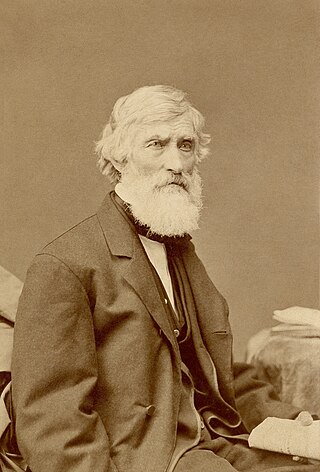
Asher Brown Durand was an American painter of the Hudson River School.
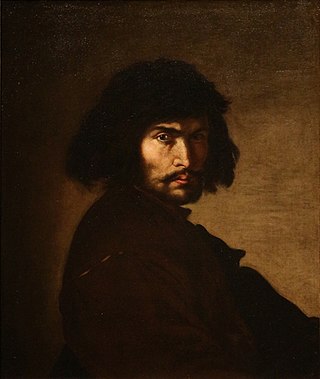
Salvator Rosa (1615–1673) is best known today as an Italian Baroque painter, whose romanticized landscapes and history paintings, often set in dark and untamed nature, exerted considerable influence from the 17th century into the early 19th century. In his lifetime he was among the most famous painters, known for his flamboyant personality, and regarded as an accomplished poet, satirist, actor, musician, and printmaker, as well. He was active in Naples, Rome, and Florence, where on occasion he was compelled to move between cities, as his caustic satire earned him enemies in the artistic and intellectual circles of the day.

John Frederick Kensett was an American landscape painter and engraver born in Cheshire, Connecticut. He was a member of the second generation of the Hudson River School of artists. Kensett's signature works are landscape paintings of New England and New York State, whose clear light and serene surfaces celebrate transcendental qualities of nature, and are associated with Luminism. Kensett's early work owed much to the influence of Thomas Cole, but was from the outset distinguished by a preference for cooler colors and an interest in less dramatic topography, favoring restraint in both palette and composition. The work of Kensett's maturity features tranquil scenery depicted with a spare geometry, culminating in series of paintings in which coastal promontories are balanced against glass-smooth water. He was a founder of the Metropolitan Museum of Art.
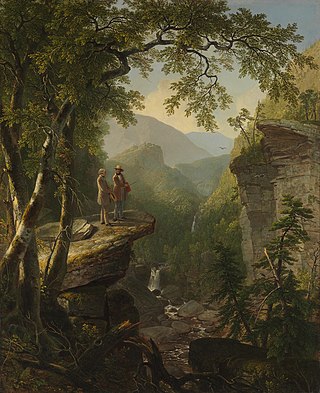
Kindred Spirits (1849) is a painting by Asher Brown Durand, a member of the Hudson River School of painters. It depicts the painter Thomas Cole, who had died in 1848, and his friend, the poet William Cullen Bryant, in the Catskill Mountains. The landscape painting, which combines geographical features in Kaaterskill Clove and a minuscule depiction of Kaaterskill Falls, is not a literal depiction of American geography. Rather, it is an idealized memory of Cole's discovery of the region more than twenty years prior, his friendship with Bryant, and his ideas about American nature.

The Montclair Art Museum (MAM) is located in Montclair in Essex County, New Jersey and holds a collection of over 12,000 objects showcasing American and Native North American art. Through its public programs, art classes, and exhibitions, MAM strives to create experiences that inspire, challenge, and foster community to shape our shared future.

View from Mount Holyoke, Northampton, Massachusetts, after a Thunderstorm, commonly known as The Oxbow, is a seminal American landscape painting by Thomas Cole, founder of the Hudson River School. The 1836 painting depicts a Romantic panorama of the Connecticut River Valley just after a thunderstorm. It has been interpreted as a confrontation between wilderness and civilization.
Florence Nightingale Levy was an American arts administrator notable for founding of the publication American Art Annual in 1898.

The Titan's Goblet is an oil painting by the English-born American landscape artist Thomas Cole. Painted in 1833, it is perhaps the most enigmatic of Cole's allegorical or imaginary landscape scenes. It is a work that "defies full explanation", according to the Metropolitan Museum of Art. The Titan's Goblet has been called a "picture within a picture" and a "landscape within a landscape": the goblet stands on conventional terrain, but its inhabitants live along its rim in a world all their own. Vegetation covers the entire brim, broken only by two tiny buildings, a Greek temple and an Italian palace. The vast waters are dotted with sailing vessels. Where the water spills upon the ground below, grass and a more rudimentary civilization spring up.
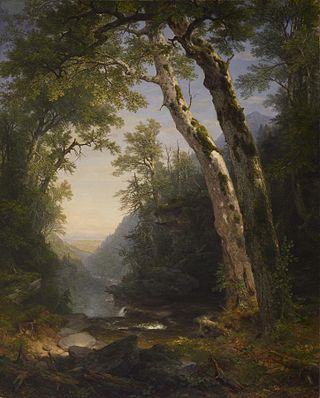
The Catskills by Asher Brown Durand, an American engraver, portraitist, and landscape artist, was commissioned by William Thompson Walters in 1858.

Sarah Cole (1805–1857) was an American landscape painter and the sister of prominent American landscape painter Thomas Cole. Although she was among the small group of early American female landscape painters, little is known about her life and few of her paintings are known to have survived.

Lake with Dead Trees, also known as Catskill, is an oil-on-canvas painting completed in 1825 by Thomas Cole. Depicting a scene in the Catskill Mountains in southeastern New York State, this work is one of five of Cole's 1825 landscapes that initiated the mid-19th century American art movement known as the Hudson River School.

Harriet Christina Cany Peale was an American landscape, portrait, and genre painter of the mid-nineteenth century. Although sometimes described as a copyist, a greater share of her oeuvre has been made public in recent years, allowing Cany Peale to earn recognition for her genre and landscape paintings. She has been located in contemporary scholarship as an artist of the Hudson River School.